A recent study of more than 117,000 data storage drives reveals a massive gap between the number of enterprise HDDs and SSDs fit for reuse and those that actually go on to a second life. While the vast majority of drives can be safely reused, bridging the “circularity gap” requires coaxing organizations – both buyers and sellers – to commit to reuse.
The findings, published in the European Journal of Electrical Engineering & Computer Science, come amid renewed concern over the rise in data center e-waste, with demand for storage capacity rapidly accelerating in light of the AI boom.
On the bright side, the study – co-authored by UK circularity leader Richard Kenny, storage expert Jonmichael Hands, and engineer Nick Hayhurst – reveals ample room for safe reuse of storage drives at scale: the circular economy has plenty of opportunity to grow, if companies take advantage of it.
E-Waste And The Importance of Drive Reuse
E-waste generation is a serious problem. According to the UN’s fourth Global E-waste Monitor (GEM), companies collectively junked 62 million tons of e-waste in 2022, a figure which is rising by about 2.6 million tons annually and projected to reach 82 million tons by 2030.
The problem has been worsening for some time: 2022 saw an 82% jump in e-waste produced, compared to 2010, amounting to a staggering $62 billion in wasted materials that could have been recovered.
At the same time, GEM reports that e-waste generation is increasing five times faster than documented e-waste recycling, which it expects to drop from 22.3% in 2022 to 20% in 2030. Shorter product life cycles, limited repair options, and inadequate e-waste management are some of the factors driving the decline.
While HDD reuse isn’t the whole solution to these unhappy trends, it is part of it. Since destroyed data storage devices represent a significant source of e-waste, encouraging drive reuse has a major role to play. There’s also a significant financial factor at play: according to Kenny, organizations are collectively missing out on a massive $24 billion annually from not reusing drives.

Related Reading
Standards such as IEEE 2883 become crucial in developing trust in non-destructive data sanitization methods such as purging. By doing so, they promote sustainable lifecycles in storage hardware, thereby advancing the larger goal of circularity.
An Overview of the Study
Clearly, a destroyed drive – once it’s shredded or incinerated – cannot be reused for storage. But what proportion of drives properly sanitized with logical methods are actually eligible for reuse?
The study in question, titled From Waste to Resource: How Standardized Health Metrics Can Accelerate the Circular Economy in Storage Media, sought to quantify drive reuse potential by analyzing 117,982 drives manufactured between 2015 and 2022.
The massive anonymized dataset comprised a wide range of drives — a mix of devices of varying capacities. These devices were subject to a consistent method of data sanitization and verification. “The only thing that changes is the drive,” Kenny explained, whose company Interact was responsible for the process.
The main finding: a staggering 87% of the drives were still reusable after proper erasure – almost eight in every nine devices remained good for a second life. In a world where most drives are destroyed, the vast majority of those drives could have been safely reused across a variety of use cases. Of those drives that didn’t make the cut, erasure failed only in 16% of SSDs and 12% of HDDs.
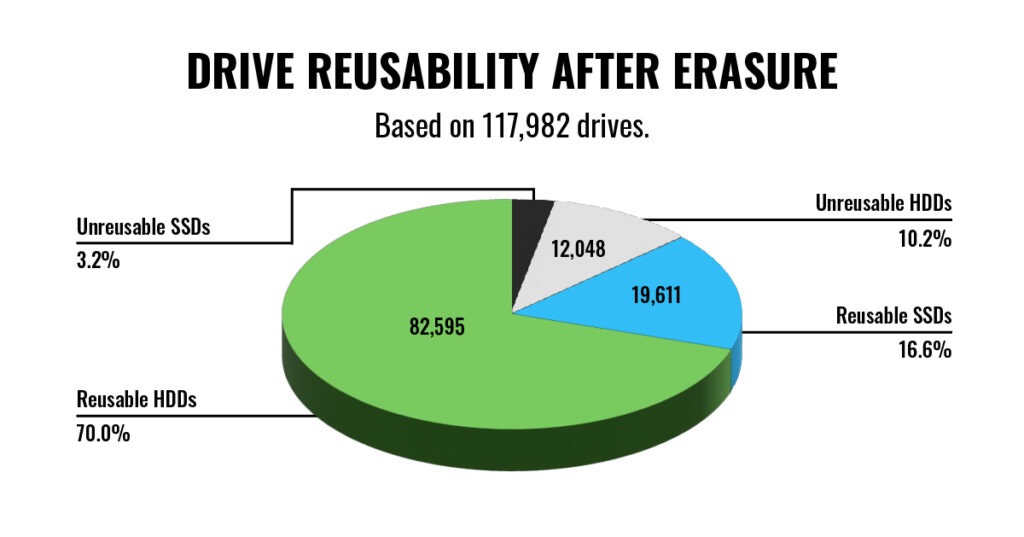
Process Methodology
Here’s a summary of how the study, the largest of its kind to measure drive reusability, was structured:
- Pre-testing: A drive that starts off busted won’t get better after sanitization. For health metrics, the study relied on S.M.A.R.T. (self-monitoring and reporting technology) attributes such as Reallocated Sector Count and Uncorrectable Error Count. Unhealthy drives were marked as un-reusable.
- Data erasure: Drives were erased according to industry standard clear and purge methods.
- Erasure verification: Even if a drive is functional, it’s not reusable if failed sanitization means data remains. The researchers verified whether sanitization was successful, and kept detailed logs on anomalies.
- Post-testing: After drives were successfully sanitized, the researchers used the same S.M.A.R.T. attributes as health metrics to determine whether sanitization degraded drive quality.
- Failure analysis: When the drives were not reusable, the study determined what factors prevented reusability after sanitization.
To ensure rigor throughout the process, the study required that erasure and verification were done in line with industry standard practices in sanitization, such as IEEE 2883-2022 and NIST 800-88 R1.

Related Reading
SMART attributes are a great way to keep tabs on the health of your drives. However, they can be tricky to interpret.
Quantifying the Circularity Gap
The circularity gap between reusability in principle and in practice is stark. While the study found that 87% of the drives were reusable after erasure, report author Richard Kenny estimates that companies reuse a meager 10-11% of them. “We have a massive gap between what can and should be reused versus what is actually being repurposed”, he explained.
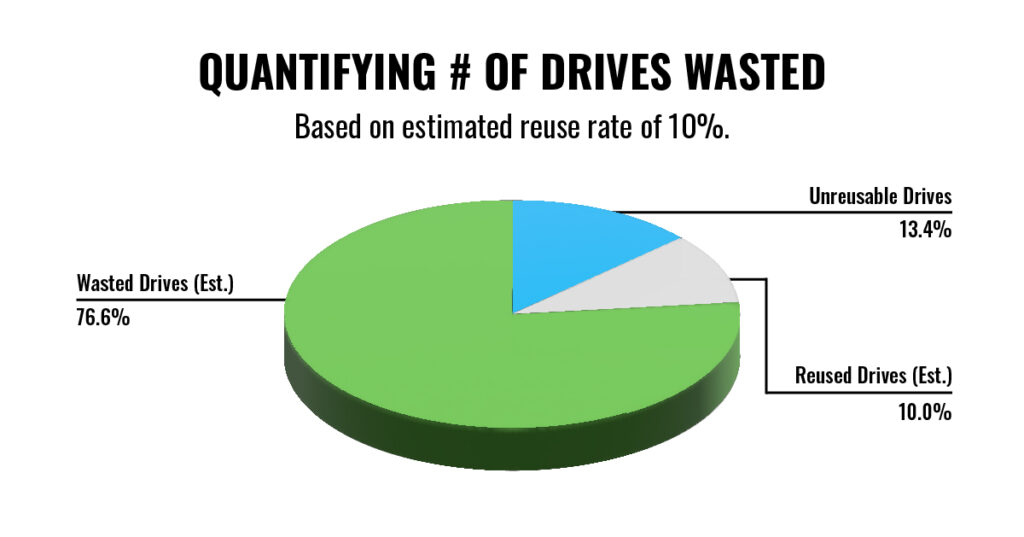
If the results of the study generalize, more than 480 million of the 628 million drives produced in 2020 will eventually be destroyed despite being fit for reuse.
The economics of this practice are startling. According to upcoming research by Kenny and his coauthors, the net missed opportunity related to drive destruction in 2020 alone was a hefty $24 billion. “If you map that our over the next eight years or so, you’re probably looking at about $200 to £300 billion economic loss associated with shredding. It’s a massive deal and it’s a huge black hole.”
Interestingly, HDDs – with a 12.7% failure rate – are slightly more likely to be reusable after erasure than SSDs, at 16%. In this way, the study opens the door for manufacturers to investigate these errors to further improve reusability post-sanitization.
However, just increasing the percentage of reusable drives won’t be enough to close the gap between potential and actual reuse. “The demand for data storage is at an all-time high and manufacturers can’t keep up,” Kenny warns. The solution? “Circular practices are vital in reducing both the missing demand and limiting the environmental cost of always using new.”
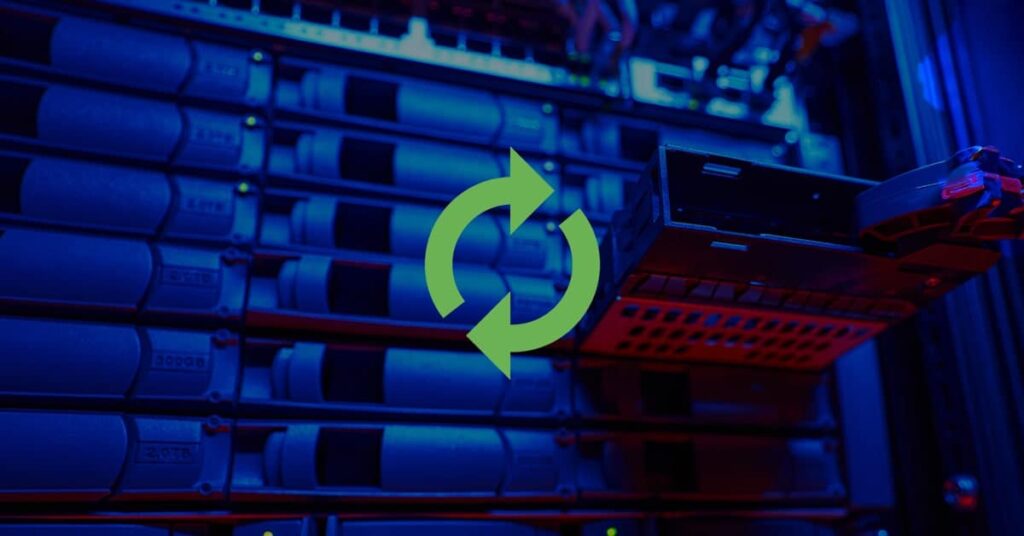
Related Reading
Many hands make light work. The Circular Drive Initiative (CDI) brings together leaders in the storage industry to brainstorm how to encourage circularity.
The Circular Drive Initiative’s Push For Sustainable Data Storage
Which Factors Make Drives Unusable?
The landmark study identified 15 top reasons why 15,776 (13.37%) of 117,982 drives failed. The most common reason for failure (28.59%) was an I/O error during the verification process. At 25.69%, the second most common reason was an I/O error during the erasure process.
It’s true that verification & erasure I/O errors account for over half of drives deemed unreusable. However, these errors account for only 7% of drives overall, since most drives are reusable.
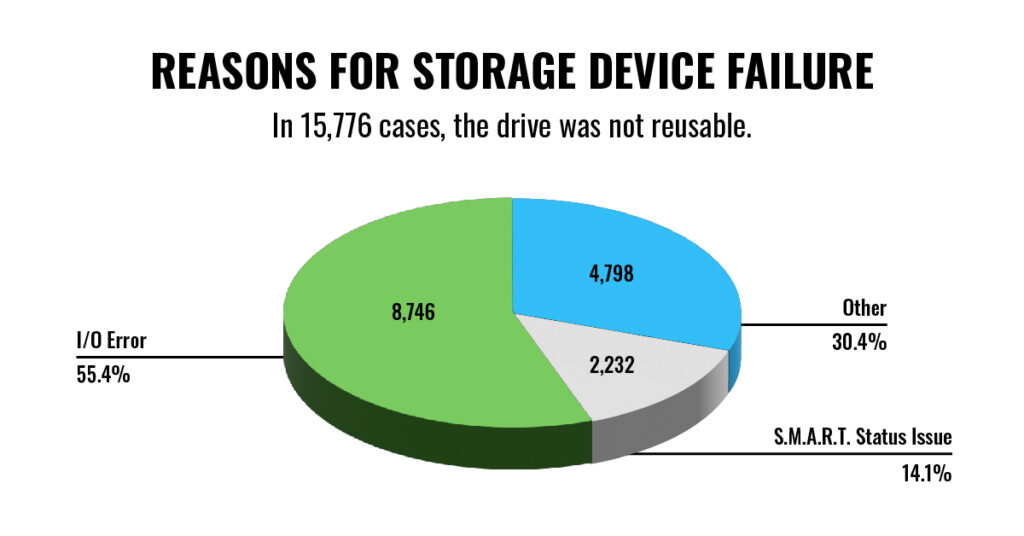
That leaves 45.72%. Of these errors, about 12% happened pre-verification, and about 13% happened post-verification. The remaining ~20% include errors that could happen either pre- or post-testing.
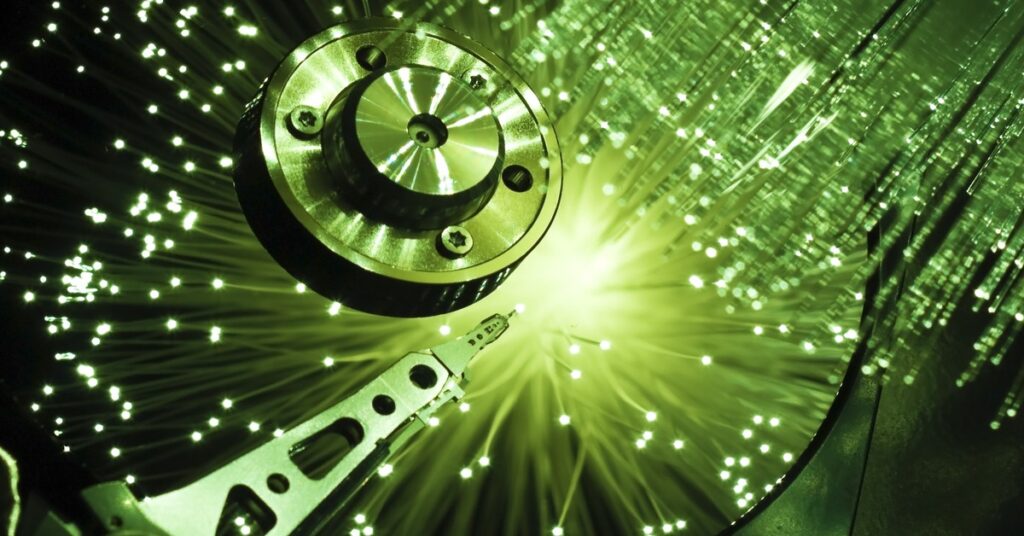
Related Reading
In between aging hardware and factory-fresh drives are factory recertified drives. These drives have seen little or no use, pass a battery of tests, and typically sell at a discount.
Overcoming Obstacles to Reuse
Reusing drives supports both environmental and economic goals by reducing e-waste and extending the lifespan of data storage devices. While technical errors during the sanitization process contribute to some of the issues, this study encourages manufacturers to work on the primary issues for drive failure that stunt reusability, such as I/O errors.
Most notably, the study highlights a major gap between the potential for drive reuse and reuse itself. Clearly, there is substantial room for improvement. So exactly what’s holding back organizations from extending the product life of drives?
Mistrust in the surety of the erasure process is the most plausible explanation for the apparent reluctance to embrace the secondary market for drives, says Kenny. “It can’t come down to health. We’ve quantified that the drives are healthy. We’ve also quantified different measures and mechanisms to allow you to de-risk the process. So it can’t come down to reliability or quality.”
To counter this sentiment, he proposes a two-fold solution: rigorous communication around the economic case for reuse and the parallel development of smart industry standards.
To this end, Kenny and his fellow members at the Circular Drive Initiative (CDI) are working on a grading system to categorize reusable drives. Grade A would be earmarked for high-sensitivity players such as financial institutions and hyperscalers. Grade B would be completely suitable for most other use cases in the enterprise. The grading system will be supported by an open access tool available through CDI.
“For me, it’s always about first creating the knowledge base and then disseminating it among as many willing partners as possible until it becomes a mantra,” he remarked. “You need to give me a reason why we can’t reuse. That’s the discussion I want us to force as an industry.”
Reuse It Or Lose It
The good news is that sanitization demonstrably works, and drives can be safely reused in most cases. Data sanitization, when guided by robust standards like IEEE 2883, can foster confidence in the safety and efficacy of reusing drives.
What’s needed, above all though, is a cultural shift. E-waste cannot continue to be the norm, certainly not in data centers and when so much value is otherwise left on the table. Instead, it’s finally time for IT managers and data center engineers to drop their hesitation and embrace the principle: Reuse it or lose it!
Find out how Horizon can help your company reduce its circularity gap by reusing drives.











